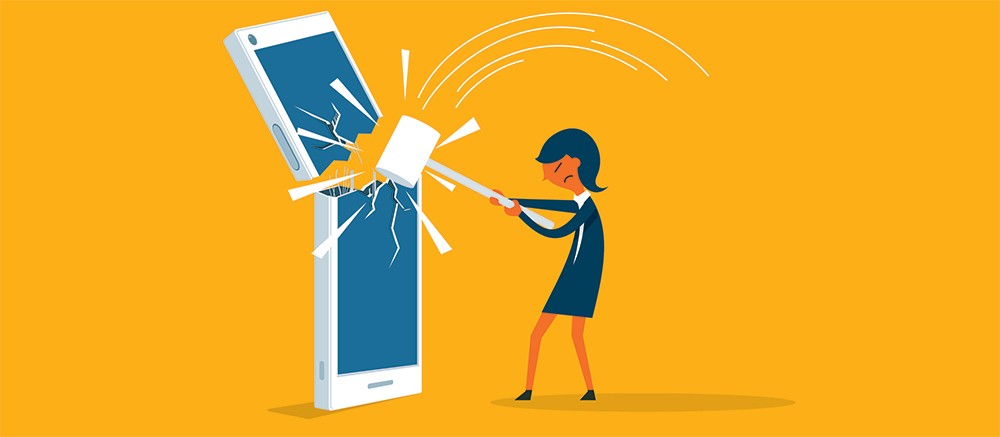Social media has been kind to Marlee Grace, an artist, dancer, author, and e-zine maker. It has given her a livelihood, connected her to new friends and collaborators, and even led her to true love. But for this free-spirited millennial, the digital world is both a blessing and a curse. When you share your work and life with 77.3K followers on Instagram, it's hard to know where your work ends and your life begins—or where your smartphone ends and your body begins. The process of documenting, posting, scrolling, and clicking can become an endless loop—a sinkhole that feels more real than virtual. "Technology gave me my whole career," she says. "But it's also made me want to die. It's very addictive."
Grace is familiar with the signs of compulsion; she got sober from alcohol and drug addiction in 2011. Though it seems to pale in comparison with substance abuse, phone addiction can be serious, too. "Both kinds of addiction are really physical," she says. "When I'm on an Instagram binge, it's hitting the dopamine in my brain. Not only are these shiny phones addictive—and so is the internet, because it's endless—but the apps [for platforms like Facebook, Snapchat, and Tinder] are designed to be like slot machines. They're designed for us to never put them down."
Grace notices that during a particularly bad spell with digital overload, her relationships suffer, and eating well and exercising go out the window. To counter that downward spiral she's had to make changes, taking steps to clarify the distinctions between work and life, virtual and real, phone and body. These are 21st-century problems, so to help others she's put it all into a book: How to Not Always Be Working: A Toolkit for Creativity and Radical Self-Care (HarperCollins, 2018). Conceived to be "part workbook, part advice manual, part love letter," it's about feeling whole again and not so disconnected. Included in that aim is a healthier relationship with what is perhaps your most intimate companion. Your ever-present appendage. Your phone.
Bottomless Scrolls and Dopamine Loops
Digital addiction doesn't just affect Instagram pros. Regular folks get addicted, too. The average person scrolls through 300 feet of digital content per day, according to Andrew Keller, global creative director of Facebook. That's about the equivalent of a football field's length, or the height of the Statue of Liberty. A big chunk of that is social media: People spend an average of 1 hour and 16 minutes on social platforms daily. Technology brings a wealth of advantages from flexible work to global connectivity, but it has a dark side. Screen addiction is ubiquitous—the unspoken epidemic of our time.The same physiological mechanisms come into play with any form of addiction—so just like with substance abuse, screen time can lead to an increase in dopamine, the neurotransmitter associated with the pleasure and reward centers of the brain. "Dopamine is the want," explains Tricia Kostin, clinical director at Summit Behavioral Health Florham Park, an outpatient facility in New Jersey with services to treat substance abuse and addiction. "You want people to like your post. You want to see what's trending and what people are talking about on social media. People can get into a dopamine loop, going from want to pleasure and reward in an endless cycle."
This effect is anything but random: Whether your dopamine loop comes from Facebook or Fortnite, the programmers planned it this way. "People get so addicted to social media because it's on a variable reward schedule," explains Kostin. "Programmers use algorithms to let you get to the next level of a video game, or they'll give you a certain amount of likes in an hour. You might get likes on social media, but they won't let you see them all at once. So you get depressed, thinking, 'No one is liking my post!' Then all of a sudden, you get a whole bunch of likes because social media waited—and then flooded you with them." Surfing the web creates a similar cycle, as we hop from one flashy website to the next. "Our brains are triggered by colors; they want to see something pretty again. The colors, lights, and graphics keep a dopamine loop going."
So many of us rely on our screens for everything—our work lives, bookkeeping, activity planning, even dating. How, then, do we know if we are addicted or just normal? "I once heard someone say in an AA meeting, 'If you think you have a problem with alcohol, then you probably do,'" says Grace. "It's the same with screens. There are also physical cues; my spine will send me messages when I'm using my phone too much. It's addiction when it affects your quality of life."
Freedom from Digital Dependency
The alcoholic can go cold turkey from drinking, but in our tech-fueled culture, flushing your phone or computer down the toilet is not an option. So what can we do to break digital addiction? "We recommend that people use a cognitive behavioral model," says Kostin, referring to the widely applied therapy that aims to help people change their behaviors and develop coping strategies to solve problems. "Rather than an extinguishment or abstinence model, this is a harm-reduction model. It's very goal-oriented and gives you a schedule or a program that you can stick to." To begin, limit your recreational screen time to only a certain number of minutes per day, setting a timer to keep yourself in check. Turn off the notifications that might lure you back online. Kostin also recommends darkening your screen brightness or using the night-shift setting on your phone, even in the daytime. Then you won't be as susceptible to the bright colors and graphics that vie for your attention.Using a similar approach, Grace has created a few rules to live by. She has experimented with setting strict digital hours (no Internet or phone between 10 pm and 10 am), and she has deleted all social media apps from her phone ("Let Facebook be the one social media thing you just do on your damn computer," she advises). She also recommends choosing a specific time of day, say 1 p.m., to give yourself the luxury of scrolling the social-media feed on your computer for a limited time—say, 20 minutes. Sleeping with your phone in a different room is essential: "If it's next to my bed I will look at it for an hour in the morning, minimum," says Grace.
You can also try a phone box, which appeals to creative types and lovers of beauty. Start with a box that fits your phone, whether it's a simple cardboard or wooden box, and make it beautiful by painting or collaging it. Create a practice of putting your phone in the box (turned off or silent) and leaving it there for a while. The point is to be without your phone for a stretch of time just beyond your comfort zone—say, two to three hours. Grace explains that the box is meant to be a temple—not so much for your phone as for your spirit. "It's not about punishing yourself. It's not, 'I'm so addicted that I need to have a phone box.' It's more like, 'I love myself so much that I am doing this.'" Putting away your phone is a way of showing up more, both for yourself and for the people in your life.
In Praise of Social Media Diets
Social media presents a paradox: On the surface, it connects us and helps us share our lives, yet in large doses it can lead to a sense of disconnection and even isolation. In a 2018 study out of the University of Pennsylvania, "No More FOMO: Limiting Social Media Decreases Loneliness and Depression," college students who restricted their time on social media to 30 minutes a day showed significant reductions in loneliness and depression compared to a control group. Prior to the study, the students spent on average twice as long on social media, with some spending up to 2.5 hours a day on the platforms. But those who followed the social media diet of 30 minutes a day (10 minutes per platform on Facebook, Instagram, and Snapchat) scored lower on the UCLA Loneliness Scale and the Beck Depression Inventory after three weeks.The study's lead author, UPenn psychologist Melissa G. Hunt, can't say for sure why limiting social media helps counter loneliness and depression, but she has some hypotheses. "We know that using social media leads to social comparison," she says. "You compare your life to the glossy, curated highlights reel you see in other people's pages, and it makes you feel worse about your own life. When you spend less time on social media, you spend more time engaging in activities that enhance self-worth, like getting your work done, and that foster authentic, intimate relationships, like having dinner with a friend." Hunt also cautions against social media's superficial emphasis on sharing "good" things and glossing over the negatives. "It gives the illusion of connection without real emotional vulnerability or support."
On the flip side, social media can offer an invaluable entrée to like-minded communities. "Being queer, it's really important to me to be able to connect to my queer community via social media," says Grace, who also meets fellow artists online. "But we don't have to let the app own our relationships." In other words, we can communicate directly instead of messaging through the app. We can create opportunities to meet in person. Grace just started a new gig running an artists' residence in a historic mansion in East Grand Rapids, Michigan, and she'll have the chance to meet many artists that she originally connected with via Instagram. "Let's use the app to get people off the app," she says. Such an action sounds deliciously disruptive to the Cyber Powers That Be.
We don't have to forswear our devices or live in a cave without social media. But we can achieve more freedom by being self-aware. Along the way, it's essential to have self-compassion. "If you're someone who's struggling with this, know that you're not a bad person," says Grace. "These apps are meant to be addictive. The programmers aren't saying, 'Oh, whoops! We made such a popular thing that everybody loves!' They designed it to be this way. So forgive yourself while you're healing."














